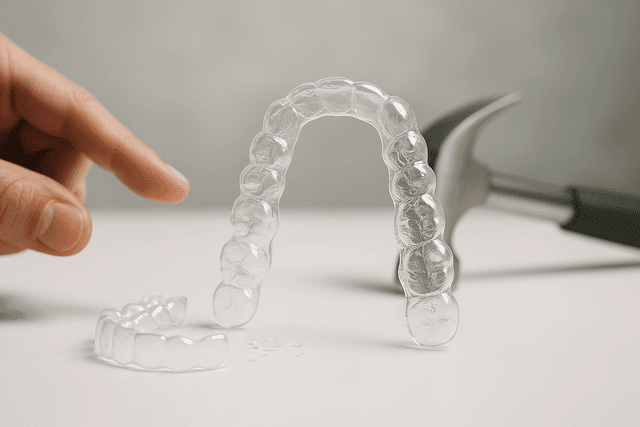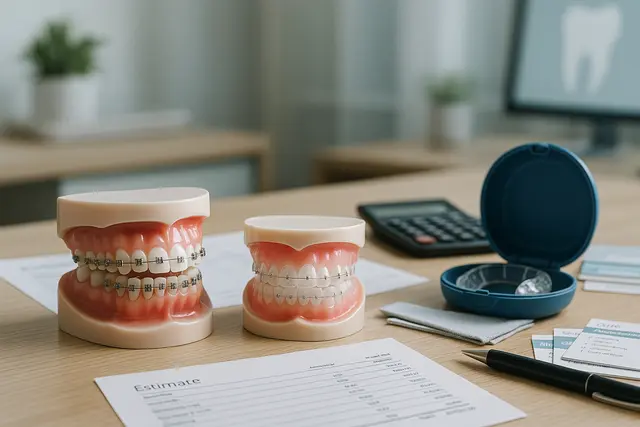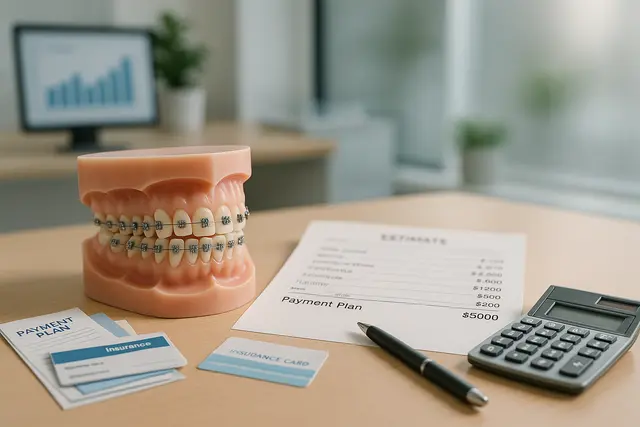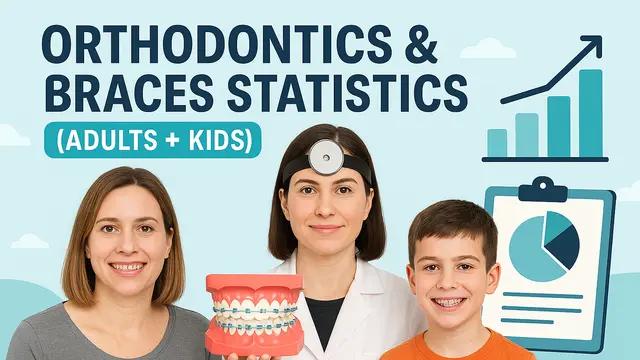Orthodontics
5 min read
Jun 06, 2025
What Is Crack Resistant Aligner Material? Benefits, Types & More
If you’re wearing clear aligners or thinking about getting them, you’ve probably wondered how these thin, see-through trays can handle daily wear without snapping. The answer lies in something called crack resistant aligner material , a smart blend of science and design that helps your aligners stay strong, clear, and effective.

If you’ve ever worn a clear aligner, you’ve probably had that tiny voice in your head whisper, Is this thing going to snap when I take it out? Don’t worry, you’re not alone. Every day, people take their aligners out to eat, brush, or show their friends how weird they look on the counter, and one of the most common fears is a sudden crack, and the panic that follows.
That’s why crack resistant aligner material exists. It’s not just a fancy feature; it’s a game-changer. Whether you’re on day two or month twelve of treatment, the strength and flexibility of your aligner material directly affect your results, your comfort, and honestly, your sanity.
What’s Actually in These Things?
Aligners aren’t just bendy pieces of plastic. They’re made from carefully engineered materials, most commonly thermoformed plastics like polyurethane or copolyester, that are shaped under heat to match the exact curve of your teeth. This isn’t some one-size-fits-all thing. Your aligner is customized down to the millimeter, using a clear aligner vacuum forming material that has to be both strong and gentle at the same time.
The goal? Create something that holds its shape, applies the right amount of pressure, and doesn’t crack when life gets messy.
Companies like Zendura and Tristar have spent years perfecting premium aligner materials that do just that. Tristar-aligner material, for instance, is known for its superior stress retention and durability, it was literally designed to withstand everyday wear and tear, while still being comfy in your mouth.
Why Does Crack Resistance Matter?
Imagine this: You’re halfway through treatment, your teeth are shifting beautifully, and then boom, you pull out your aligner and it splits. That tiny crack ruins the whole vibe. Suddenly, your appliance isn’t doing its job. Maybe it doesn’t fit quite right, or worse, it pinches your gum or a tooth edge. Now you’re either rushing to your orthodontist or trying to MacGyver a solution until your next tray.
That’s why crack resistance isn’t just a bonus, it’s a must. A high-quality, crack resistant aligner is designed to endure real-life handling. Not just the gentle “two-finger pull” your dentist recommends, but also the one-handed yank you do when you're rushing to that lunch meeting. Life happens, and your aligner needs to be ready. For adults managing busy routines, durability is even more important.
Let’s Talk About Durability
Durability goes hand-in-hand with crack resistance. The material used in clear aligners and retainers isn’t supposed to last forever, but it should absolutely last until your next scheduled tray switch. That means it needs to resist not just cracking, but also warping, staining, and losing shape after repeated wear.
We’re talking about a tiny appliance doing a big job. A good aligner should handle chewing forces (yes, we know you're not supposed to chew with them in), temperature changes, and the occasional drop into the bathroom sink.
Multi-layered materials are now being used in some of the most durable dental appliances. These stack multiple layers of polymer to create a material that’s both flexible and rigid, a weird-sounding combo that actually helps keep pressure consistent while resisting breakage. Some even call it “smart plastic.” It remembers its shape and bounces back better than single-layer sheets.
Aligners vs. Retainers: The Same… But Not
Here’s where it gets interesting. Aligners are meant to move your teeth. Retainers are meant to hold them still. Both need strength, but retainers take the cake when it comes to needing long-term toughness.
That’s why the retainer material has to be even more durable. It’s designed to sit quietly in your mouth, night after night, often for years. One small crack and suddenly your carefully aligned smile starts to drift. That’s not just annoying, that’s expensive.
Choosing a retainer material with superior resistance to cracks, wear, and stains can make the difference between a one-time purchase and a repeat headache. A lot of dental offices now use materials originally developed for medical devices, because they’re proven to last longer and stand up to the pressure of real-world use.
So, What Should You Look For?
If you’re a patient choosing between clear aligners, or if you’re just curious about what’s going in your mouth, here are a few good signs you’re dealing with a high quality dental product:
Clarity that lasts: Ultra-clear materials stay see-through over time. Cloudiness usually means lower-quality plastic or poor stain resistance.
A little thickness is a good thing: Thicker aligners tend to resist cracks better, especially if you tend to take them out in a hurry.
Ask about the brand: If your orthodontist mentions Zendura or Tristar-aligner material, that’s a green flag. These are trusted in the industry and backed by years of research.
Check for thermoforming process: Thermoformed aligners, shaped using heat and vacuum, are more precise and typically stronger than mass-manufactured alternatives.
Also, suppliers like Tiger’s Plastics or Pearson Dental Supply are popular for a reason. They source durable, premium materials that labs and dental professionals trust.
The Takeaway
Crack resistant aligner material isn’t about hype, it’s about creating an appliance that fits your lifestyle as much as your smile. It’s the quiet powerhouse behind predictable tooth movement, shorter treatment times, and fewer late-night “I broke my tray!” emergencies.
The next time you slide an aligner into place or pop out your retainer before brushing, take a second to appreciate the engineering packed into that clear little shell. It’s not just plastic. It’s a specialized product, crafted with the right elasticity, rigidity, and clarity to stand up to real life.
And if you ever do crack one? Don’t panic. Just call your orthodontist, they’ve seen it all, and they’ll get you back on track.
What Is Crack Resistant Aligner Material?
Crack resistant aligner material refers to specially engineered plastics like polyurethane or copolyester designed to withstand daily wear and tear without splitting. These materials offer a balance of flexibility and strength to maintain shape, apply steady pressure, and resist cracking during removal or use.
Why Does Crack Resistance Matter in Clear Aligners?
Crack resistance ensures your aligners stay functional throughout each wear cycle. A cracked aligner can compromise tooth movement, cause discomfort, or require an emergency replacement. Durable aligners reduce the risk of treatment delays and improve overall comfort and reliability.
Are Aligners and Retainers Made From the Same Material?
Not exactly. While both use strong thermoformed plastics, retainers often use even more durable materials since they’re meant for long-term use. Aligners move teeth gradually over months; retainers hold them in place for years, so long-term crack and stain resistance is essential.
How Can I Tell If My Aligner Material Is High Quality?
Look for brands like Zendura or Tristar, which are trusted for durability and stress retention. High-quality aligners should remain clear, have a slightly thicker feel for crack protection, and be thermoformed for a snug, precise fit. If your dentist uses premium materials, that’s a good sign.
Read Next
Related Posts

Orthodontics
Retainer That Looks like Braces: Benefits for Long-Term Alignment
A retainer might not get as much attention as braces, but it plays a crucial role in maintaining your smile after orthodontic treatment. Whether you're new to retainers or curious about the type that looks like braces, understanding their purpose and benefits is key to keeping your teeth aligned for the long haul.
6 min read
Sep 15, 2025

Orthodontics
How Much Are Metal Braces? Cost Comparison With Other Options
Thinking about getting braces but overwhelmed by the cost? You’re not alone. Orthodontic treatment can be a major investment, and understanding the different price points, from metal braces to clear aligners, can help you make a smart, confident decision.
5 min read
Sep 15, 2025

Orthodontics
Orthodontics & Braces Statistics (Adults + Kids)
Orthodontics has transformed from a niche medical service for teenagers into a booming sector that spans all ages. Today, both adults and children seek orthodontic treatment to improve their smiles, fix bite issues, and boost self-confidence.
4 min read
Aug 21, 2025
Don’t have time to research every dentist around you?
See why 30k+ patients trusted us